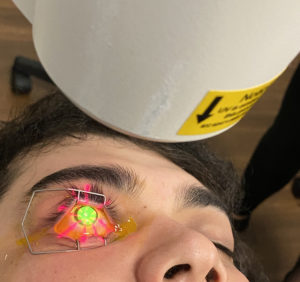Collagen Cross-Linking
In San Diego, CA
Am I a Candidate for Collagen Cross-Linking?
In addition to patients who suffer from keratoconus, other patients who may be candidates for corneal crosslinking are individuals who have disorders such as:
- Corneal ulcers unresponsive to antibiotics
- Other corneal infections
- Pellucid marginal degeneration
- Ectasia (corneal weakness)
- Corneal instability after radical keratotomy
Corneal crosslinking procedures can also be combined with various LASIK corrections for patients in need of both. Certain eye conditions may preclude a CXL procedure.

At American Eye Associates and California Retina Associates, we offer a wide range of cutting-edge treatments, expert surgical techniques, and the latest diagnostic services that will help you live your most healthy and comfortable life. We are happy to offer ophthalmology services to men and women in San Diego, Chula Vista, and the surrounding areas of Imperial County, California. Contact us to schedule your one-on-one consultation with one of our expert ophthalmologists today.
Frequently Asked Questions
What Is Collagen Cross Linking?
Collagen cross-linking (CXL) is a relatively new method of treating keratoconus, an eye disorder in which the normally globe-shaped cornea loses its ability to hold its shape, bulging and becoming conical. Collagen cross-linking works by strengthening the corneal tissue to stop it from bulging. During this procedure, eye drops containing riboflavin (vitamin B2) are applied to the cornea and activated by ultraviolet light. This process strengthens the collagen fibers, or crosslinks, within the cornea. This enables these crosslinks to act as corneal anchors, preventing the cornea from further bulging into an irregular shape. Several other uses have also been identified for this ocular treatment.
Originally developed in Germany, it has been used in Europe and in many other parts of the world, successfully for many years. In the United States, it was FDA approved in 2016.
What Is The CXL Procedure Like?
Prior to the CXL procedure, the ophthalmologist performs a full eye examination to check visual acuity, general eye health, and the thickness of the cornea. A corneal topography, which maps the area, will also be performed. Before beginning the procedure, anesthetic eye drops are administered to the patient. The CXL procedure itself involves administering riboflavin drops to the eyes. These drops flood the cornea, which is subsequently activated by ultraviolet A (UV-A) light for up to 30 minutes.
In most cases, the procedure takes 60 to 90 minutes to perform. Afterwards, antibiotic and anti-inflammatory eye drops are administered and a bandage contact lens is inserted. The eye is bandaged overnight. There is pain after the procedure, but pain medication may be prescribed and most of the pain subsides within 12 hours.
Although the CXL procedure is not touted as a cure for keratoconus, it is being investigated and used to prevent the progression of this disease process. Evidence shows that CXL is able to prevent further loss of vision in patients with keratoconus and to make corneal transplants for the condition unnecessary. Corrective lenses are still required after CXL and a change in prescription may be needed. In some cases, patients may be required to wear hard contact lenses after the surgery.
What Are The Types Of CXL Procedures?
There are two basic types of corneal crosslinking procedures currently in use:
- Epithelium-off
- Epithelium-on (transepithelial)
The epithelium-off procedure, in which the thin top layer of the eye is removed, permits more rapid penetration of the riboflavin. During the epithelium-on procedure, the surface layer remains intact, necessitating a longer penetration time for the riboflavin. Research studies have shown that 99 percent of patients who have undergone either type of CXL procedure retain stable corneal shape or show significant improvement. There continues to be some debate about which procedure is preferable.
What Are The Risks Of a CXL Procedure?
CXL is a very safe, almost always effective, procedure. It does not carry the risks of a corneal transplant procedure.
What Is The Recovery Like From CXL?
Patients undergoing CXL should expect pain during the first 2 days after surgery, as well as extreme sensitivity to light. They may also experience a haze that causes their vision to blur for up to a few weeks. During recovery, analgesics may be taken to relieve pain. The blurring of vision may make driving or work impossible until the patient is fully recovered.
Normally, a one-time CXL is all that is necessary to preserve vision and the CXL procedure does not interfere with any subsequent eye surgery. The CXL procedure has proven effective in strengthening the cornea, both in the laboratory and in clinical studies. For patients with keratoconus this is extremely important, since, left untreated, the condition may lead to permanent blindness.
